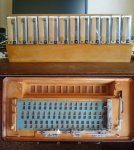You know what they say about people with more money than sense... but anyway, I couldnt resist this deal even if I cannot do it any justice.
<ATTACHMENT filename=Morinos.jpg index=4>
I got this for about 450 USD / 350 GBP locally. It was ordered in the 1960s and was last serviced at the Hohner factory in the 1990s.
<ATTACHMENT filename=Treble.jpg index=2>
<ATTACHMENT filename=Bass.jpg index=3>
Some specs:
I was expecting this one to be much bigger than the older IVM since it has 4 more keys, but the keys are narrower.
Compared to my older Morino IVM:
Keys:
And the weights, which I havent verified:
Everything works. Registers are fine. Tuning is fine. Free bass is fine. Valves are fine, except some of the lowest bass valves are slightly open.
The only problem is some M and H treble notes in the highest octave are slow to start or dead. As you can see below, there are some metal bits on the inside that are covered in a white residue. The particles have fallen off and I believe they are choking up the reeds. Ill open and clean it tomorrow. Should I just wipe those metal parts, or should I treat them with something?
<ATTACHMENT filename=Residue.jpg index=1>
Also, there was a triple Hohner mic attached to the treble grille. The foam backing has disintegrated completely and made a powdery mess. I got the cable too. Are these any good (if it still works)?
<ATTACHMENT filename=Mic.jpg index=0>
Two quick videos of what it sounds like:
Testing L, LH, LMMMH, M:
Testing MMM:
<ATTACHMENT filename=Morinos.jpg index=4>
I got this for about 450 USD / 350 GBP locally. It was ordered in the 1960s and was last serviced at the Hohner factory in the 1990s.
<ATTACHMENT filename=Treble.jpg index=2>
<ATTACHMENT filename=Bass.jpg index=3>
Some specs:
- 45 treble - LMMMH (sounds dry for a triple musette)
- 164 bass
- 106 Stradella, without Dim chords - the 7s are without root, so they act as Dims for the row above
- 58 free bass
I was expecting this one to be much bigger than the older IVM since it has 4 more keys, but the keys are narrower.
Compared to my older Morino IVM:
Keys:
- VIM: 18-18.5mm each - 53cm total
- IVM: 20 mm each - 51cm total
- Key travel on the VIM are a few mms shallower than on the IVM
And the weights, which I havent verified:
- VIM: ~ 15kg
- IVM: ~ 11 kg
Everything works. Registers are fine. Tuning is fine. Free bass is fine. Valves are fine, except some of the lowest bass valves are slightly open.
The only problem is some M and H treble notes in the highest octave are slow to start or dead. As you can see below, there are some metal bits on the inside that are covered in a white residue. The particles have fallen off and I believe they are choking up the reeds. Ill open and clean it tomorrow. Should I just wipe those metal parts, or should I treat them with something?
<ATTACHMENT filename=Residue.jpg index=1>
Also, there was a triple Hohner mic attached to the treble grille. The foam backing has disintegrated completely and made a powdery mess. I got the cable too. Are these any good (if it still works)?
<ATTACHMENT filename=Mic.jpg index=0>
Two quick videos of what it sounds like:
Testing L, LH, LMMMH, M:
Testing MMM:

















